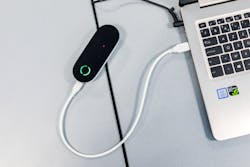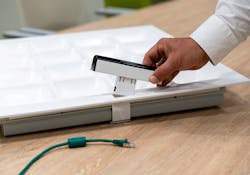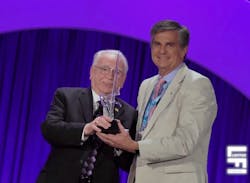Long before Randy Reid, president of LumEfficient, began working directly with Light Fidelity (LiFi) technology, his company owned the URL “LiFi.com,” originally purchased around 15 years ago to use with plasma lighting. His company didn’t use the URL much and it had nothing to do with data transfer, which LiFi is associated with nowadays, so when LiFi began taking off four or five years ago, Reid decided to sell the domain.
Today, LumEfficient has been working with LiFi for two years and has won awards from LightFair International (LFI) and the Illuminating Engineering Society (IES) for its LiFi products, becoming a fully fledged player in the LiFi industry.
“At that time, I had no idea that I would be in the LiFi business,” says Reid, “and I constantly kick myself that I didn’t, you know, have the insight to buy it (the domain) myself.”
While its roots date back as far as the 1880s to Alexander Graham Bell’s photophone invention, LiFi as we know it today was first brought to the world’s stage by Professor Harald Haas at Scotland’s University of Edinburgh in 2011 via a TedX Talk, which since then, has garnered over 2.7 million views. His company, pureLiFi, remains one of the major players in the industry, along with Signify (Philips Lighting), Reid’s LumEfficient, VLNComm and Oledcomm, although more companies working with LiFi do exist and continue to enter the field. Visit www.lifi.co/lifi-companies for a more complete list.
LiFi, which uses visual light communications (VLC) technology, remains the one of the fastest, most stable and the most secure methods to transmit data, since it uses lightwaves instead of radiowaves (which WiFi, 4G and 5G employ). Light, unlike radiowaves, cannot pass through walls and only delivers data to areas of illumination, making the technology particularly useful for industries requiring extra levels of security, such as finance, military or government. LiFi-enabled fixtures with LiFi modems are connected to Ethernet cables, which then transmit data via lightwaves. Access keys, or dongles, connected to computers, tablets or other devices have LiFi transmitters and receivers, which pick up the transmitted data. And as the radio frequency spectrum gets exponentially more crowded, we expect that the need for technology like LiFi will increase, too.
For those in the electrical wholesaling industry, this relatively young technology is one to watch as it continues to develop and gain footage as a mainstream technology. We last covered LiFi in the February 2019 edition of Electrical Wholesaling and wanted to see what has changed, and what hasn’t, since then.
What’s New?
Signify, one of the global leaders in lighting including LiFi, has worked with the technology since 2018. Ed Huibers, head of business development for LiFi at Signify, says one of the biggest changes to LiFi in the last year has been its speed.
“We’re now, let’s say, looking at 250 megabits one-way communication, and tests we’ve published also showed 50 gigabits per second using LiFi,” he shares. According to Signify’s site (www.signify.com/global/innovation/trulifi), 250 megabits per second (mbps) is fast enough to stream 30 1080p HDTV movies simultaneously.
More conservatively, Reid says the industry’s average is around 150 mbps, but both his estimate and Signify’s speeds increased since EW’s last report, which cited LiFi’s average speed to be around 100 mpbs. At the time, we also referenced a Fast Company report, which said lab tests showed LiFi’s potential to reach speeds up to 224 Gigabits per second (Gbps), so LiFi has room to grow when it comes to speed.
Another change since last year is the number of players within the industry. Huibers added that as the technology has advanced, so has the number of companies within the supply chain, especially component makers, which he expects to be beneficial for business.
“In the end, the customer wants to have multiple sources where he can buy the technology,” Huibers says. “So that’s good news, basically, that other companies are scaling as well. That makes our lives a little easier because then people accept the technology faster.”
Additionally, Reid, who is also editor and publisher for the EdisonReport and executive director of the National Lighting Bureau (NLB), says one of the major developments he has seen recently with LiFi is companies looking for alternative wavelengths to carry data. For example, Oledcomm, based in Paris, began working with infrared waves to combat the challenges of having to create the perfect luminaire.
Reid shares: “They (Oledcomm) told me, ‘We’ll never have the right fixture, the right chromaticity, the right CRI, the right wattage — we’re just never going to have the right one. Therefore, we’re just going to have a little puck in the ceiling that doesn’t give out light but does transmit data through invisible light.’” Ultimately, this advancement means one SKU instead of several, Reid adds, along with faster speeds.
What’s Stayed the Same?
One of the biggest technological pieces that has remained for LiFi is the use of a USB-based access key, or dongle, that must be connected to a device for the product to be compatible with a LiFi product. This is viewed as a challenge to the widespread acceptance of LiFi among everyday consumers used to wireless connections.
“We all thought we’d be further along than we are,” Reid says, pointing to device manufacturers as the main culprits (think Apple, Lenovo, etc.). He remembers the industry’s excitement when Apple began building LiFi drivers into their products in Jan. 2016, but since then, there has been little to no advancement on the device manufacturing side.
“They are not building LiFi into the devices, so you still have to have a dongle,” Reid adds. “Two years ago, you had to have a dongle. Five years ago, you had to have a dongle. And in 2020, you still have to have a dongle plugged into your iPad or laptop.”
And while the use of an access key may be hurting LiFi’s general popularity, it does have its advantages. More industries are beginning to come around to LiFi as a solution to their security issues. Reid says current LiFi customers of his include Georgia Tech University and the U.S. Navy. He anticipates seeing a rise within the financial technology sector, since they cannot use wireless technology because of security.
Additionally, the military are prime candidates for LiFi. “At the beginning of the day, they hand out 10 dongles to 10 different people, and at the end of the day, they collect those dongles and lock them in a safe,” Reid explains, adding that while the use of an access key may be hurting LiFi’s widespread use, it will keep it popular among early adopters who need it for security purposes.
Looking Ahead
Both Reid and Huibers anticipate LiFi to really explode in the next two to three years, as data consumption expands; radio frequency wavelengths grow more crowded; and the need for faster, more secure data transmission increases. “You have to imagine that every two years, our data consumption doubles globally,” says Huibers. “We really are on the edge of the capabilities of radio communication, like WiFi, 4G, 5G, etc. So if we want to stay connected, we need to find other means.”
Reid believes another major obstacle to LiFi taking off is 5G, as device manufacturers currently work toward 5G compliance. “That’s kind of the holy grail or light at the end of the tunnel,” he explains. “When they finish their 5G projects, they’re going to start on LiFi.”
Meanwhile, it’s important for electrical distributors to learn the ways LiFi can serve as a potential revenue booster. Once 5G is fully implemented, it will be faster than its predecessor, 4G, but it will be expensive and lack the security LiFi has to offer. For many, a combination of WiFi, 5G and LiFi will provide the best connections.
And given the current COVID-19 pandemic, both Huibers and Reid expect the healthcare sector and rise in remote work to help drive the need for LiFi. Recently, Huibers has been talking to more doctors and hospitals about the benefits of LiFi, especially as temporary hospitals with older and/or experimental equipment pop up where sensitivity to radio is higher. When it comes to remote work, Reid believes one of the long-term effects of the coronavirus outbreak is people realizing going into the office isn’t necessary. If remote work becomes more common, so will the need for a fast, secure and stable connection for the everyday person.
Huibers says , additional sectors he has seen begin to accept LiFi include hotels, which despite the need for access keys, want to deliver faster, more secure connections for their guests, and the airline industry. About six months ago, Signify made a deal with a company on airplanes, and by 2021, Huibers says the first airplanes equipped with LiFi will be flying. Reid also says LiFi has a future in vehicle-to-vehicle (V2V) technology, which would allow vehicles’ front and tail lights to communicate with each other for safer, quicker transportation.
Ultimately, Reid believes LiFi is a technology and reps can make money off of. Unlike much of the lighting equipment imported in mass from China or found on Amazon, LiFi (at least for now) is exclusive and will hopefully go through the traditional channels of distribution, he adds.
Huibers, who has worked in the electrical wholesaling field, says while not every distributor will want to add LiFi to their offerings, they do have a unique opportunity to provide added value to LiFi beyond just the technology, from design services to LiFi training.
LiFi has continued to grow since its inception in 2011, but much has to happen before it becomes widely adopted. Nevertheless, it’s a technology bound to gain footage if and when lighting companies, communication companies (e.g. Verizon, AT&T, etc.) and device manufacturers accept and implement LiFi into their products and systems. But just like WiFi took 10 years to take off, Huibers reminds, LiFi may simply need more time.
“New technology always takes longer to take off,” adds Reid, paraphrasing Steve Jobs. “But once it does take off, it reaches the masses faster than you think. And that could be the way (with LiFi).”




